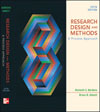 Research Design and Methods: A Process Approach, 5/e Kenneth S. Bordens,
Indiana University/Purdue University - Fort Wayne
Bruce Barrington Abbott,
Indiana University/Purdue University
Making Systematic Observations
Chapter OutlineDeciding What to Observe
Choosing Specific Variables for Your Study
Research Tradition
Theory
Availability of New Techniques
Availability of Equipment
Choosing Your Measures
Reliability of a Measure
Reliability of a Physical Measure
Reliability of Population Estimates
Reliability of Judgments or Ratings by Multiple Observers
Reliability of Psychological Tests or Measures
Accuracy of a Measure
Validity of a Measure
Acceptance as an Established Measure
Scale of Measurement of a Measure
Nominal Scales
Ordinal Scales
Interval and Ratio Scales
Variables and Scales of Measurement
Choosing a Scale of Measurement
Information Yielded
Statistical Tests
Ecological Validity
Adequacy of a Dependent Measure
Sensitivity of the Dependent Measure
Range Effects
Tailoring Your Measures to Your Research Participants
Types of Dependent Variables and How to Use Them
Behavioral Measures
Physiological Measures
Self-Report Measures
Choosing When to Observe
The Reactive Nature of Psychological Measurement
Reactivity in Research with Human Participants
Demand Characteristics
Other Influences
The Role of the Experimenter
Reactivity in Research with Animal Subjects
Automating Your Experiments
Detecting and Correcting Problems
Conducting a Pilot Study
Adding Manipulation Checks
Summary
Key Terms |
| 


 2002 McGraw-Hill Higher Education
2002 McGraw-Hill Higher Education